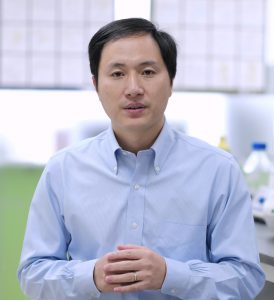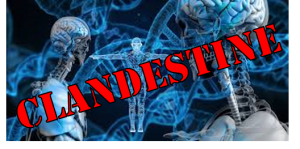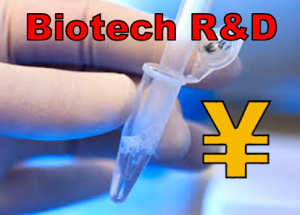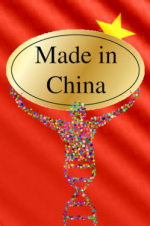[Editor’s Note: Returning guest bloggers Mr. Joseph DeFranco and Dr. James Giordano explore the emerging geo-political ramifications and associated ethical implications of recent advances in genetic engineering. Read on to learn how China is currently positioned to drive the evolution of this brave new world!]
Gene editing (i.e., directly modifying an organism’s genetic material to achieve a desired effect and outcome) has been used as a viable technique for several decades. It has been intended and employed for treating a variety of conditions, including immunodeficiency and blood disorders, and certain types of cancers. Recently, gene editing methods were augmented by the discovery  of Clustered Regularly Interspaced Short Palindromic Repeats (CRISPR) and its associated Cas9 nuclease. CRISPR techniques enable a more simplified and rapid approach to altering cellular DNA, and thus modifying genetic information. Despite the relative ease afforded by CRISPR/Cas9, the method is not without problems, including the production of mutations by incurring “off-target” genetic edits. Yet, such issues and limitations appear to be little more than proverbial “speed bumps” in the paths to broadening capabilities afforded by what is likely a game-changing tool in and for molecular biology – and perhaps the production of bioweapons and instruments of non-kinetic disruption, as well.1
of Clustered Regularly Interspaced Short Palindromic Repeats (CRISPR) and its associated Cas9 nuclease. CRISPR techniques enable a more simplified and rapid approach to altering cellular DNA, and thus modifying genetic information. Despite the relative ease afforded by CRISPR/Cas9, the method is not without problems, including the production of mutations by incurring “off-target” genetic edits. Yet, such issues and limitations appear to be little more than proverbial “speed bumps” in the paths to broadening capabilities afforded by what is likely a game-changing tool in and for molecular biology – and perhaps the production of bioweapons and instruments of non-kinetic disruption, as well.1
 In November 2018, Chinese Scientist Dr. He Jiankui claimed to have used CRISPR/Cas9 to edit the CCR5 gene of human embryos to generate an inherited resistance to HIV, smallpox, and cholera.2 Although it appears that this genetic modification will create a resistance to certain types of infections, altering CCR5 expression may have other phenotypic effects, as well. For example, studies by Joy and colleagues showed that the deletion of the CCR5 gene may affect memory; and therefore this specific gene edit may have modified the cognitive functions of these “CRISPR babies.”3 Whether this mutation was intended or not, off-target mutations should be expected until certain extant gaps in knowledge of genomics, proteomics, and neuroscience are understood and bridged. A report published in Nature Medicine suggests that this gene edit could detrimentally affect the normal lifespan of the gene edited babies,4 in part by making individuals more susceptible to other viral infections (e.g., influenza virus5 and West Nile virus6 ).
In November 2018, Chinese Scientist Dr. He Jiankui claimed to have used CRISPR/Cas9 to edit the CCR5 gene of human embryos to generate an inherited resistance to HIV, smallpox, and cholera.2 Although it appears that this genetic modification will create a resistance to certain types of infections, altering CCR5 expression may have other phenotypic effects, as well. For example, studies by Joy and colleagues showed that the deletion of the CCR5 gene may affect memory; and therefore this specific gene edit may have modified the cognitive functions of these “CRISPR babies.”3 Whether this mutation was intended or not, off-target mutations should be expected until certain extant gaps in knowledge of genomics, proteomics, and neuroscience are understood and bridged. A report published in Nature Medicine suggests that this gene edit could detrimentally affect the normal lifespan of the gene edited babies,4 in part by making individuals more susceptible to other viral infections (e.g., influenza virus5 and West Nile virus6 ).
 Of course, a number of questions arise from He’s work. First is whether embryos should be edited, and if so, is enough known about the novel CRISPR-Cas9 method to employ it in approaches to modifying human genetics. A complete discussion of these ethico-legal questions is beyond the scope of this blog but are addressed elsewhere in some detail.7 Second, what opportunistic circumstances led to, or allowed for, the practice of what many are deeming to be “ethically fuzzy” science? To be sure, international standards for research (e.g., The Nuremberg Code8 ; etc.9 ) have been recognized by the scientific community. But the needs, values, and precepts that contribute to and/or constitute ethical principles are not necessarily homogeneous across cultures. Thus, as cutting-edged bioscientific research becomes an ever-more international enterprise, distinctions in cultural norms, mores, and practices can – and increasingly will – be placed in stark relief.
Of course, a number of questions arise from He’s work. First is whether embryos should be edited, and if so, is enough known about the novel CRISPR-Cas9 method to employ it in approaches to modifying human genetics. A complete discussion of these ethico-legal questions is beyond the scope of this blog but are addressed elsewhere in some detail.7 Second, what opportunistic circumstances led to, or allowed for, the practice of what many are deeming to be “ethically fuzzy” science? To be sure, international standards for research (e.g., The Nuremberg Code8 ; etc.9 ) have been recognized by the scientific community. But the needs, values, and precepts that contribute to and/or constitute ethical principles are not necessarily homogeneous across cultures. Thus, as cutting-edged bioscientific research becomes an ever-more international enterprise, distinctions in cultural norms, mores, and practices can – and increasingly will – be placed in stark relief.
There may have been some attempt to gauge the international reaction to the use of CRISPR/Cas9 technologies to modify human embryos. After the initial pushback from several nations, the Chinese government declared that Dr. He was a “rogue” scientist. This we find difficult to believe. China’s seamless triple helix of government, academia, and industry enable purposive synchronization and synergy of initiatives,10 which allows rapid resource and personnel deployment for national directives. The confirmation of a second Chinese CRISPR pregnancy in early 201911 only adds to our disbelief – and non-acceptance – that such efforts are the work of rogue scientists who are operating without the full knowledge and endorsement of the Chinese government.

Given that CRISPR/Cas9, along with other gene editing tools, can be used for disruptive purposes (e.g., development of “designer pathogens” not currently listed/governed by international bioweapon treaties and conventions; alteration of human structure and functions; modification of agricultural systems, etc.), we posit that such advancements can pose defined risks and threats to global security.12 In March 2019, the World Health Organization’s newly formed advisory committee for international governance on human genome editing determined that such modifications to human germlines are “irresponsible”.13 The committee proposed the need for a central registry of human genome editing research in order to facilitate more detailed insight to – and stringent and oversight of – risks and hazards.
The recognition and acknowledgment that CRISPR methods could be used to generate novel biological weapons have prompted studies of reversing CRISPR-induced effects. A recent article in the MIT Technology Review identified laboratories that are working to find “anti-CRISPR” molecules: proteins in nature that can “turn off” CRISPR-induced gene edits.14 Such efforts reflect steps to control open source research and counter the potential use of gene-editing to produce biological weapons and/or affect global health, and this is noteworthy. However, such regulation may not be  encompassing or sufficient. Of growing concern in this light are clandestine enterprises (i.e., biohacking) and research activities of nation-states and/or non-state actors that blatantly disregard international standards and guidelines. In June 2019, a Russian scientist declared plans to implant gene-edited embryos into women.15 Clearly, this announcement comes after numerous appeals for an international moratorium on germline editing;16 thereby reinforcing the reality that CRISPR-based methods are relatively easy to develop and use, but not necessarily easy to regulate, govern, and control.
encompassing or sufficient. Of growing concern in this light are clandestine enterprises (i.e., biohacking) and research activities of nation-states and/or non-state actors that blatantly disregard international standards and guidelines. In June 2019, a Russian scientist declared plans to implant gene-edited embryos into women.15 Clearly, this announcement comes after numerous appeals for an international moratorium on germline editing;16 thereby reinforcing the reality that CRISPR-based methods are relatively easy to develop and use, but not necessarily easy to regulate, govern, and control.
While the use of gene editing techniques to create lethal and/or destructive agents is certainly possible, we believe that it is far more feasible – and perhaps more effective and efficient – to pursue the use of gene-edited agents in “mass disruptive” non-kinetic engagements. Such precision disruption can exploit a society’s vulnerabilities, and generate ripple effects to unsettle various domains and dimensions of geo-political stability and power. For example, allowing human use of gene editing techniques could foster attraction of both researchers seeking to advance potential translational applications of genetic methods (i.e., “research tourism”), and patients seeking newly developed gene-editing interventions (i.e., “medical tourism”) for the treatment of certain diseases as well as genetic modification for “wellness” and/or enhancement. Moreover, the use of gene editing techniques to modify crops, livestock, and to change environmental flora and fauna can incur equally disruptive effects on global ecologies, markets, and economics.
Without doubt, the economic aspects and advantages of global hegemony of bioscience, biotechnology, and biomedicine are focal to China’s ongoing strategic plan.17 The Wall Street Journal reported that China spent the equivalent of approximately $410 billion (USD) in research and development (R&D) in 2016.18 This is in contrast to the United States’ R&D investment,  which allocated only 1.7% ($66.5 billion USD) of the federal budget in 2017. Additionally, China has increased educational programs in order to realize the intent to become the global leader in science, technology, engineering, and medicine (STEM) graduates by 2030. According to the World Economic Forum, China graduated almost five million STEM students from universities in 2016, which dwarfs the United States graduates in that year (around 1.8 million).19 As China takes more of an interest, and makes increasingly greater investments in the life sciences, it is apparent that this will be one of the new frontiers of economic and diplomatic engagement.20
which allocated only 1.7% ($66.5 billion USD) of the federal budget in 2017. Additionally, China has increased educational programs in order to realize the intent to become the global leader in science, technology, engineering, and medicine (STEM) graduates by 2030. According to the World Economic Forum, China graduated almost five million STEM students from universities in 2016, which dwarfs the United States graduates in that year (around 1.8 million).19 As China takes more of an interest, and makes increasingly greater investments in the life sciences, it is apparent that this will be one of the new frontiers of economic and diplomatic engagement.20
![]() Given China’s stated intent to become a – if not the – global superpower within the next 30 years, a vital question is what kind(s) of engagement(s) will this prompt or demand. Any meaningful answer must appreciate the hegemonic views and objectives of China (and other strategically competitive nations) as well as those of the United States and its allies. Will the U.S. be content to become “a superpower among superpowers,”
Given China’s stated intent to become a – if not the – global superpower within the next 30 years, a vital question is what kind(s) of engagement(s) will this prompt or demand. Any meaningful answer must appreciate the hegemonic views and objectives of China (and other strategically competitive nations) as well as those of the United States and its allies. Will the U.S. be content to become “a superpower among superpowers,”  and if so, what does this portend for activities of preparation, cooperation, and collaboration? Or, will there be a durable struggle for global power supremacy (in and among the many domains), and what does this infer or establish for competition, combativeness, or (some sort of) capitulation? These decisions are crucial as we determine and articulate programs and policies of scientific, technological, and socio-political investment and activity for the decade(s) to come. Quoting the late Lee Iacocca, we ask: who will “…lead, follow, or get out of the way”21 and what will such postures entail and obtain?
and if so, what does this portend for activities of preparation, cooperation, and collaboration? Or, will there be a durable struggle for global power supremacy (in and among the many domains), and what does this infer or establish for competition, combativeness, or (some sort of) capitulation? These decisions are crucial as we determine and articulate programs and policies of scientific, technological, and socio-political investment and activity for the decade(s) to come. Quoting the late Lee Iacocca, we ask: who will “…lead, follow, or get out of the way”21 and what will such postures entail and obtain?
If you enjoyed reading today’s post, please also see the following blog posts:
Dead Deer, and Mad Cows, and Humans (?) … Oh My! by LtCol Jennifer Snow, Dr. James Giordano, and Joseph DeFranco
The Importance of Integrative Science/Technology Intelligence (InS/TINT) to the Prediction of Future Vistas of Emerging Threats by Dr. James Giordano, CAPT (USN – Ret.) L. R. Bremseth, and Joseph DeFranco
Benefits, Vulnerabilities, and the Ethics of Soldier Enhancement
China’s Drive for Innovation Dominance
… as well as Hank Greely‘s presentation on Future Legal and Ethical Implications of Bio Technology from the Mad Scientist Bio Convergence and Soldier 2050 Conference, 8-9 March 2019 in Menlo Park, CA
Authors:
Joseph DeFranco was J5 Donovan Group Fellow in Biowarfare and Biosecurity, at U.S. Special Operations Command (USSOCOM). He is currently studying neuroscience in the College of Arts and Sciences, and biodefense at the Schar School of Policy and Government of George Mason University, VA, and formerly served on the staff of Congressman Donald S. Beyer (VA-08). His current research focuses upon the possible use of novel microbiological agents and big data as force-multiplying elements in non-kinetic, hybrid, and kinetic engagements, and the role of global agencies in biosecurity.
Mad Scientist James Giordano, PhD, is Professor of Neurology and Biochemistry, Chief of the Neuroethics Studies Program, and Co-Director of the O’Neill-Pellegrino Program in Brain Science and Global Law and Policy at Georgetown University Medical Center. He currently serves as an appointed member of the Neuroethics, Legal, and Social Issues (NELSI) Advisory Panel of the Defense Advanced Research Projects Agency (DARPA). Dr. Giordano previously served as J5 Donovan Group Senior Fellow, Biowarfare and Biosecurity, U.S. Special Operations Command (USSOCOM); Senior Science Advisory Fellow of the Strategic Multilayer Assessment Group of the Joint Staff of the Pentagon; and Senior Research Fellow and Task Leader for the EU Human Brain Project Subproject on Dual Use Brain Science.
Disclaimer: The views expressed in this blog are those of the authors, and do not necessarily reflect those of the Department of Defense, U.S. Special Operations Command, the Defense Advanced Research Projects Agency (DARPA), Department of the Army, Army Futures Command (AFC), or Training and Doctrine Command (TRADOC).
Acknowledgments: This blog was adapted from the authors’ forthcoming work appearing in the PRISM journal and an interview (of JG) conducted by Stew Magnussen for National Defense Magazine (https://www.nationaldefensemagazine.org/articles/2019/3/26/editors-notes-national-security-implications-of-gene-editing). JG’s work is supported in part by funding from CSCI, Leadership Initiatives, and federal funds UL1TR001409 from the National Center for Advancing Translational Sciences (NCATS), National Institutes of Health, through the Clinical and Translational Science Awards Program (CTSA), a trademark of the Department of Health and Human Services, part of the Roadmap Initiative, “Re-Engineering the Clinical Research Enterprise.”
References:
1 DeFranco J, DiEuliis D, Bremseth LR, Snow JJ, Giordano J (2019). Emerging Technologies for Disruptive Effects in Non-Kinetic Engagements. Journal of the Homeland Defense & Security Information Analysis Center, 6(2).
2 Regalado, A. (2018, November 26). Chinese scientists are creating CRISPR babies. Retrieved from https://www.technologyreview.com/s/612458/exclusive-chinese-scientists-are-creating-crispr-babies/
Kolata, G., Wee, S. L., & Belluck, P. (2018, November 26). Chinese Scientist Claims to Use Crispr to Make First Genetically Edited Babies. Retrieved from https://www.nytimes.com/2018/11/26/health/gene-editing-babies-china.html
3 Joy, M. T., Assayag, E. B., Shabashov-Stone, D., Liraz-Zaltsman, S., Mazzitelli, J., Arenas, M., Abduljawad, N., Kliper, E., Korczyn, A. D., Thareja, N. S., Kesner, E. L., Zhou, M., Huang, S., Silva, T. K., Katz, N., Bornstein, N. M., Silva, A. J., Shohami, E., & Carmichael, S. T. (2019). CCR5 is a therapeutic target for recovery after stroke and traumatic brain injury. Cell, 176(5), 1143-1157.
Regalado, A. (2019, February 21). China’s CRISPR twins might have had their brain inadvertently enhanced. Retrieved from https://www.technologyreview.com/s/612997/the-crispr-twins-had-their-brains-altered/
4 Wei, X., & Nielsen, R. (2019). CCR5-∆ 32 is deleterious in the homozygous state in humans. Nature medicine, 1.
5 Falcon, A., Cuevas, M. T., Rodriguez-Frandsen, A., Reyes, N., Pozo, F., Moreno, S., Ledesma, J., Martínez-Alarcón, J., Nieto, A., & Casas, I. (2015). CCR5 deficiency predisposes to fatal outcome in influenza virus infection. Journal of General Virology, 96(8), 2074-2078.
6 Glass, W. G., McDermott, D. H., Lim, J. K., Lekhong, S., Yu, S. F., Frank, W. A., Pape, J., Cheshier, R. C., & Murphy, P. M. (2006). CCR5 deficiency increases risk of symptomatic West Nile virus infection. Journal of Experimental Medicine, 203(1), 35-40.
7 For sources which discuss the ethico-legal questions of CRISPR and gene editing, please see: Brokowski, C., & Adli, M. (2019). CRISPR ethics: moral considerations for applications of a powerful tool. Journal of molecular biology, 431(1), 88-101.
Reyes, A. P., & Lanner, F. (2017). Towards a CRISPR view of early human development: applications, limitations and ethical concerns of genome editing in human embryos. Development, 144(1), 3-7.
Caplan, A. L., Parent, B., Shen, M., & Plunkett, C. (2015). No time to waste—the ethical challenges created by CRISPR. EMBO reports, 16(11), 1421-1426.
8 For more information on the Nuremberg Code, please see: https://history.nih.gov/research/downloads/nuremberg.pdf
& https://www.loc.gov/rr/frd/Military_Law/pdf/NT_war-criminals_Vol-II.pdf
9 For more examples of international standards for research, please see:
The Belmont Report: https://www.hhs.gov/ohrp/regulations-and-policy/belmont-report/index.html
United States Department of Health & Human Services, Responsible Conduct of Research: https://ori.hhs.gov/ori-introduction-responsible-conduct-research
World Health Organization, Ethical standards and procedures for research with human beings: https://www.who.int/ethics/research/en/
10 Ibid. ref. 1.
11 O’Callaghan, J. (2019, January 24). Chinese officials circle as a second CRISPR pregnancy is confirmed. Retrieved from https://www.wired.co.uk/article/second-crispr-baby
12 DeFranco J, Bremseth LR, Giordano J. The Importance of Integrative Science/Technology Intelligence (InS/TINT) to the Prediction of Future Vistas of Emerging Threats. Mad Scientist Laboratory Post #125, 13. March 2019. Available online at: https://madsciblog.tradoc.army.mil/125-the-importance-of-integrative-science-technology-intelligence-ins-tint-to-the-prediction-of-future-vistas-of-emerging-threats/
13 WHO expert panel paves way for strong international governance on human genome editing (2019, March 19). Retrieved from https://www.who.int/news-room/detail/19-03-2019-who-expert-panel-paves-way-for-strong-international-governance-on-human-genome-editing
14 Regalado, A. (2019, May 2). The search for the kryptonite that can stop CRISPR. Retrieved from https://www.technologyreview.com/s/613309/the-search-for-the-kryptonite-that-can-stop-crispr/
15 Cyranoski, D. (2019). Russian biologist plans more CRISPR-edited babies. Nature, 570(7760), 145.
16 Wolinetz, C. D., & Collins, F. S. (2019). NIH supports call for moratorium on clinical uses of germline gene editing.
17 Chen C, Andriola J, Giordano J. (2018). Biotechnology, commercial veiling and implications for strategic latency: The exemplar of neuroscience and neurotechnology research and development in China. In: Davis ZD, Nacht M. (eds.) Strategic Latency Red, White and Blue: Managing the National and International Security Consequences of Disruptive Technologies. Livermore, CA: Lawrence Livermore Press, pp. 12-32.
18 Emanuel, E., Gadsden, A., & Moore, S. (2019, April 19) How the U.S. Surrendered to China on Scientific Research. Retrieved from https://www.wsj.com/amp/articles/how-the-u-s-surrendered-to-china-on-scientific-research-11555666200
19 The World Economic Forum’s 2016 Human Capital Report: http://reports.weforum.org/human-capital-report-2016/measuring-human-capital/?doing_wp_cron=1486038808.8636078834533691406250
20 Gehrke, J. (2019, July 2). Genetic information is the newest front in US-China great power competition. Retrieved from https://www.washingtonexaminer.com/policy/defense-national-security/genetic-information-is-the-newest-front-in-u-s-china-great-power-competition
21 Woodruff, D. (1992, August 24). Mr. Iacocca, Please Go Graciously. Retrieved from https://www.bloomberg.com/news/articles/1992-08-23/mr-dot-iacocca-please-go-graciously



